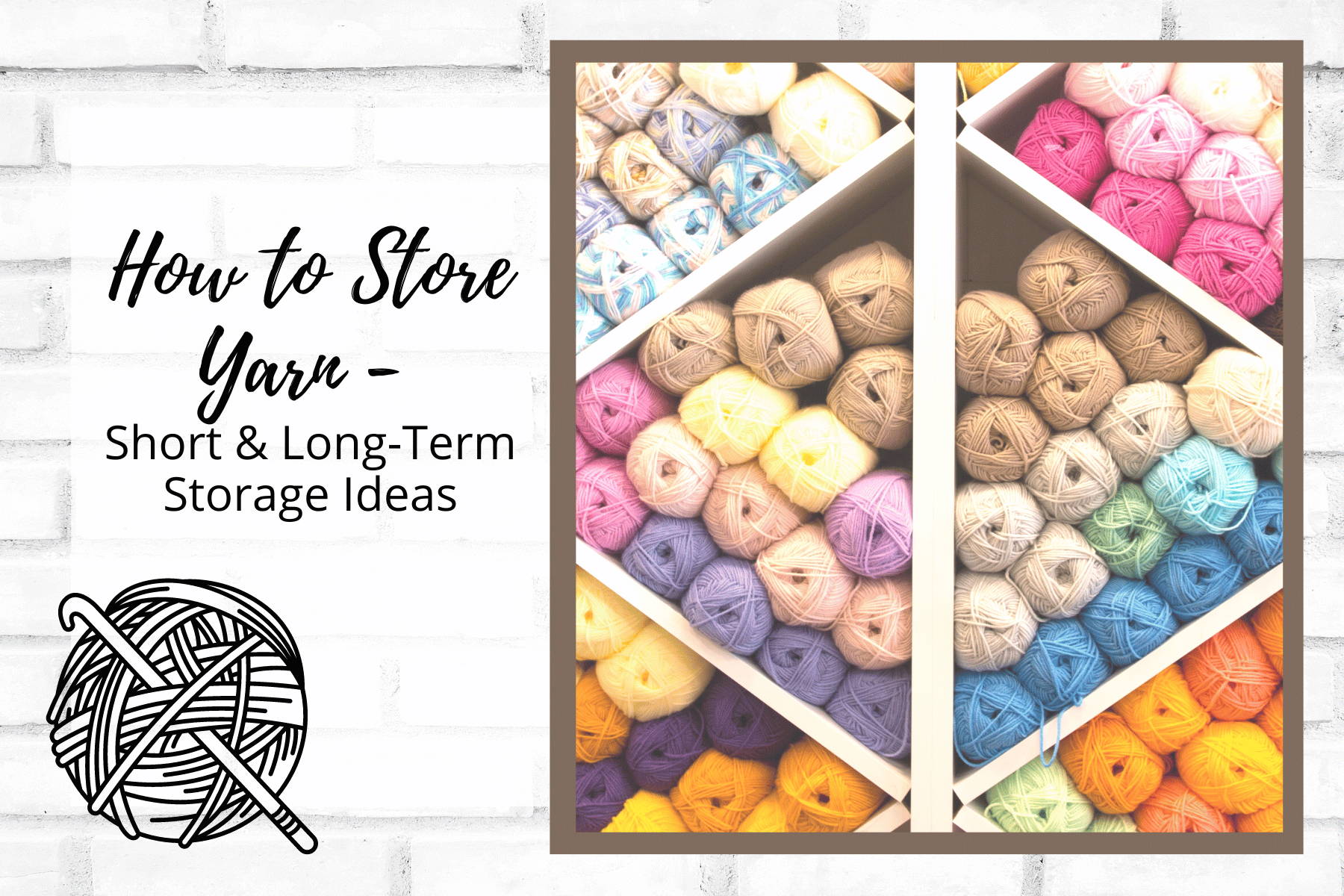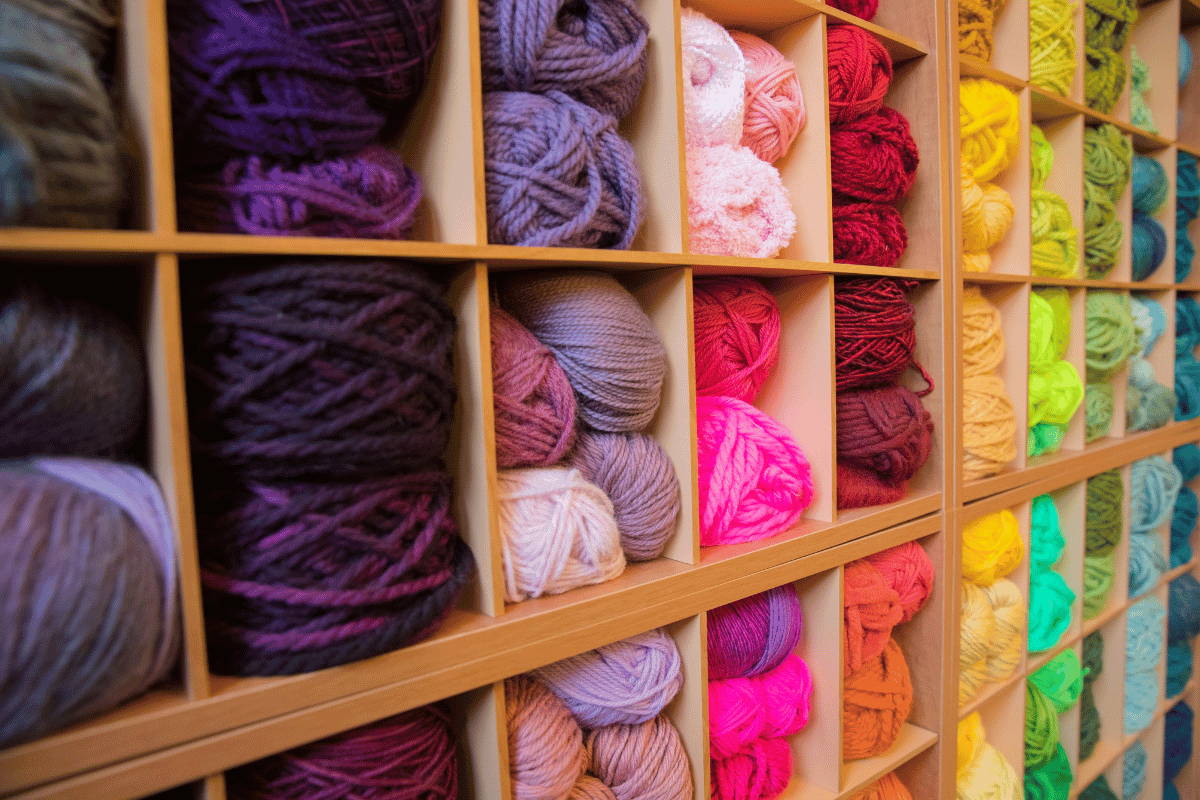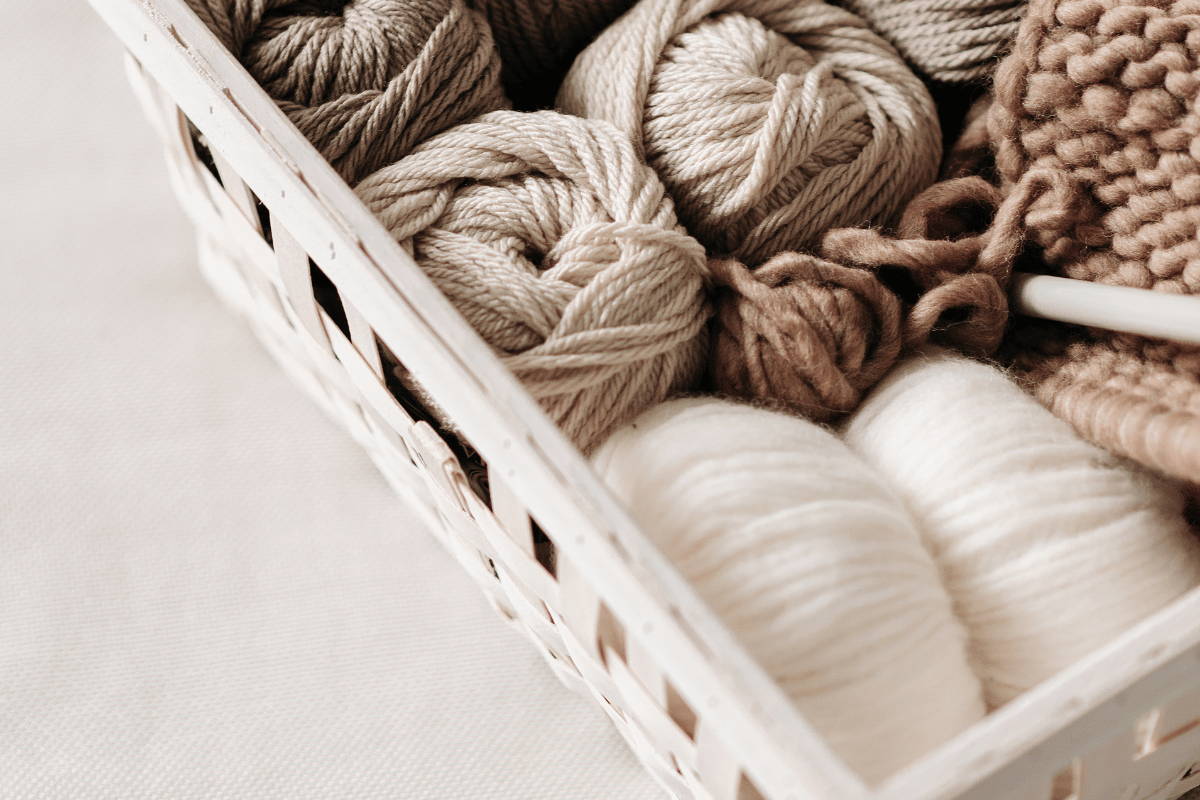How to Store Yarn - Short & Long-Term Storage Ideas
When it comes to crafting and working with yarn, the way you store your materials can have a major impact on the quality of your projects.
Whether you are looking for short-term ideas to keep your workspace organized or long-term storage solutions that will keep your supplies in good condition while they’re not being used, there are lots of great methods & tools for keeping your yarn organized and manageable.
Here are some of the best short-term and long-term storage ideas for yarn that will help keep your crafting workspace neat and tidy, and make sure that you have easy access to all the supplies you need when inspiration strikes!

Best Ways to Store Yarn for Knitting and Ideas to Organize Your Stash

For knitted projects to turn out the way you want them to, it’s important that you keep your yarn safe and organized. Storing and organizing your yarn correctly can save time and money, and prevent frustration when starting a project.
With the right storage methods, you can make sure all of your yarn is easy to access, properly protected, and organized to keep you motivated. Here are the best ways to store yarn for knitting and ideas to organize your stash.
1. Store Yarn in Airtight Boxes
Storing yarn correctly is essential for preserving its quality and preventing damage. One of the best ways to keep your yarn safe and dry is to store it in airtight boxes. This will protect the yarn from pests, dust, dirt, and other debris that can ruin the texture of the yarn.
Additionally, an airtight box allows you to keep the yarn out of direct sunlight, which can cause colors to fade or become dull. It will also keep moisture away and prevent mold from forming on your yarn.
2. Vintage Cabinet or Locker
Vintage cabinets are generally made out of wood, making them strong and durable, while also adding a bit of character to the room they’re in. Not only that, but they often have drawers or shelves, which make it easy to store yarn so that you can easily access it.
Vintage lockers come in a variety of colors and styles, so you can find one that will fit perfectly with the rest of your décor.
3. Keep Yarn in an Old Hutch
An old hutch provides ample space for organizing and storing a variety of types of yarn. The tall shelves are perfect for holding large skeins, while the drawers can be used to store smaller amounts of yarn or specialty items.
The cabinet also offers additional storage for any other knitting supplies you may have. The wood of an old hutch helps protect yarn from excessive light and heat, which can cause fading or damage to the fibers.
4. Use a Folding Yarn Caddy
A folding yarn caddy is an ideal choice for storing your yarn while you work on a project. Unlike bulky plastic storage bins or boxes, a folding caddy can be folded up when not in use and stored away easily.
This makes it perfect for those who are short on space, as well as those who travel frequently. The lightweight collapsible design makes it easy to move from one place to another.
Folding yarn caddies come in a variety of sizes, shapes, and colors so that you can find the perfect fit for your needs. They have multiple compartments to ensure that each skein of yarn is secure and organized. Most models feature an adjustable hook, which makes it easy to keep your yarn unwound while you work.
In addition to being convenient and portable, a folding caddy also offers superior protection for your yarn. It helps to prevent dust, dirt, and pet hair from collecting on the skeins. This will help to preserve the integrity of the yarn for years to come.
5. Yarn Stash Bag or a Large ToteBag
Using a yarn stash bag or alternatively, a large tote bag to store yarn projects is not only convenient but also highly recommended. These bags keep everything organized and helps prevent tangles, damage and unraveling of delicate threads.
The spacious interiors provide ample storage for all of your supplies such as crochet hooks, needles, and scissors. Plus, the extra pockets are great for storing patterns and other notions.
The bag also provides portability. Whether you're taking your projects to a friend's house, visiting family out of town, or attending a yarn event, these bags make it easy to carry everything with you. The sturdy handles will keep your projects secure, and the lightweight construction won't weigh down your supplies.
The Dos and Don’ts of Yarn Storage
Whether you’re an experienced fiber artist or just beginning to explore the craft of yarn crafting, it’s important to know the dos and don’ts of yarn storage.
Store your yarn in a dry, dark place.
If exposed to too much direct light or damp conditions, yarn can fade, discolor and weaken over time. To make sure your yarn remains in good condition and is ready to use whenever you need it, make sure you store it in a dry, dark place.
Storing yarn away from direct sunlight or dampness is the best way to protect its colors and texture for years to come. Additionally, you should make sure that your yarn is away from extreme temperatures, as this can cause it to become brittle and weak.
Keep insects (moths/carpet beetles) out of your yarn.
Insects such as moths and carpet beetles pose a significant threat to the quality of your yarn. These pests can damage the natural fibers in the yarn, leaving them weak and prone to breakage. In addition, their larvae can consume large amounts of material, resulting in holes or thinning areas in the yarn where they have eaten away at the fibers.
The damage caused by these pests can be costly in terms of both time and money, as it may require purchasing new yarn or even replacing a completed project. Preventing infestations before they start is far easier than dealing with them once they have taken hold.
Store all yarn in a climate-controlled environment.
Yarn is a delicate material that needs to be stored in the right environment in order to maintain its quality and luster. Storing yarn in extreme temperatures or humidity can cause it to lose shape, fade, or become brittle.
A climate-controlled storage space helps to maintain a consistent temperature and humidity level. This prevents the yarn(such as beautiful Pop yarn) from being exposed to drastic changes in the weather that can cause damage or discoloration. It also prevents dampness and mold growth, which can make yarn unusable.
A climate-controlled environment is also beneficial for preserving delicate materials such as natural fibers like cotton, wool, and silk. These materials are more vulnerable to changes in temperature and humidity than synthetics. Keeping them in a consistent climate helps to preserve their texture, color, and durability.
Do not store yarn in baskets on rugs.
Using baskets and rugs to store yarn addsadditional moisture sources that can damage the fibers. The yarn will absorbhumidity from its surroundings, which can cause it to swell and alter itstexture, making it difficult to work with. Furthermore, storing yarn on a rugmay attract moths or other insects that are drawn to wool products, resultingin damage to the yarn.
Do not store unlaundered garments.
Unwashed yarn garments tend to attract dirt,dust, and other particles, which can discolor the fabric and make it look dullor dingy over time. It can also be difficult to get rid of any bacteria thatmight have collected on the yarn during storage.
Additionally, storing unwashed yarn garmentscan cause them to become musty from moisture and humidity. This can lead to badodors and the growth of mold or mildew on the fabric, making it unusable. Theycan also become brittle due to a lack of natural oils that help keep the fabricsupple.
It is important to always launder your yarngarments before storing them in order to avoid any of these issues. Properlywashing and drying the fabric ensures that it is free from dirt, dust,bacteria, and other particles.
How to Organize Your Yarn for Quick and Easy Access
If you’re an avid knitter or crocheter, chances are, you’ve got a stash of yarn in your home. It can be difficult to keep track of all the different colors and fiber types, so it’s important to have an organized system for storing your yarn.
Organizing your yarn by fiber makes it easier to find the right yarn for a project. It also helps you keep track of what fibers you already have, which can make shopping much simpler. Here are some tips on organizing your yarn by fiber:

● Sort your yarn into piles according to fiber type. Start with basic categories like wool and acrylic, then separate the different varieties within each of those categories. For example, you can have a pile for super wash wool and another for merino wool.
● Label each pile by fiber type so you can quickly identify it. This will save you time when searching for the right yarn for a project.
● Store each fiber separately. This will make it easier to find what you need and keep your yarn from getting tangled or mixed up.
● Keep track of the yardage for each fiber type. This will help you to determine if you have enough yarn for a specific project and prevent overbuying or running out halfway through.
Organize your yarn by yarn weight
Organizing your yarn by weight is an excellent way to keep your stash organized and easy to find. It also makes it easier to plan out projects, since you’ll know exactly what type of yarn you need foreach one.
Label your yarn by the weight class so you know what kind of yarn it is. You can use a simple system like A (for light), B(for medium), and C (for bulky). If you want to include more categories, like super bulky or fine, feel free to do so.
Then, sort your yarn by the labels you made. Place all A’s in one bin, all B’s in another, and so on. This will make it easier to find the right type of yarn when you need it.
Lastly, we recommend that you make a list of all the different weights of yarn you have in your stash. This will help you keep track of how much yarn you have in each weight class so that you can plan out projects accordingly.
Label your Yarn
Labeling your yarn is important for keeping your collection organized. Not only will it help you easily find the color and weight of the yarn you need, but labeling also allows you to keep track of how much yarn is left in each skein.
You can use any kind of label, but it should include the fiber type, weight of the yarn, and dye lot number (if applicable).It is also helpful to add any other information that might be important, such as yardage or what project the yarn was originally purchased for.
Secure the tails before storing
When storing yarn, make sure to secure the tails before putting them away. This helps to keep your yarn from tangling and unraveling, which can cause a variety of problems. Not only does this help with organization and storage, but it also prevents any projects you may have been working on from unraveling or coming undone.
Securing the tails of the yarn can be done in a variety of ways, such as tying it into a knot, wrapping it around something sturdy to secure it, or even using a needle and thread. This simple step can help ensure that your projects stay intact and ready for you to use.
Consider cataloging your yarn
When it comes to organizing your stash of yarn, cataloging is the way to go. Cataloging will help you keep track of what yarns you have and in what colors, weights, and fiber types. It's also a great way to make sure you get the most out of every skein and ball of yarn you own —by having a catalog of all the yarns you have, you'll never buy a duplicate without knowing it.
There are several ways to go about cataloging your yarn stash. You can create an inventory spreadsheet that lists each type of yarn, the colors, weights, and amounts of each skein or ball. You can also take pictures of the yarns you own to keep a visual record of your stash.
If you're really ambitious, make detailed notes about each yarn, such as its yardage and gauge range.
Bottom Line: How to Store Yarn
Storing yarn correctly is essential for keeping it in the best possible condition for years to come. Our tips above will ensure soft cotton yarn and colorful, ready for knitting or crocheting. With a bit of extra effort, your yarn can be enjoyed for many projects now and in the future.

